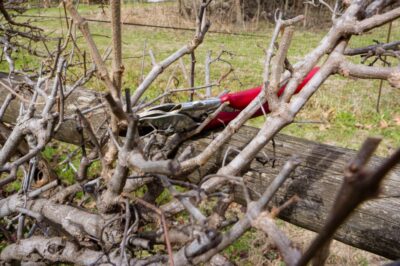 Winter is actually the best time of year to prune deciduous plants. It’s called dormant pruning, and it’s a gift you can give your trees and shrubs.
Winter is actually the best time of year to prune deciduous plants. It’s called dormant pruning, and it’s a gift you can give your trees and shrubs.
Let’s take a look at the many dormant pruning benefits and when to prune trees in New York and New Jersey.
First, What Is Dormant Pruning?
Dormant pruning happens after a plant has stopped growing for the summer and before new growth appears in the spring — when the plant is dormant.
This dormant period is a great time to remove diseased or dead branches or reshape an overgrown plant. It’s a time for more serious pruning than the typical maintenance pruning you’d do during a plant’s growing season.
Dormant Pruning Benefits
There are lots of benefits to dormant pruning:
- Without all the leaves in the way, you can see what you’re doing. The structure of your tree or shrub’s branches is obvious, and easy to follow as you cut. And limbs are lighter and easier to handle.
- In winter, there’s less chance of transmitting diseases from one plant to another through pruning.
- Damaged or dead wood can be an entry point for insects or disease that will then spread to healthy tissues of a plant. Prune it out now, before spring.
- Fresh pruning cuts and bruises typically heal faster during the dormant season and are also less likely to attract disease-carrying insects.
- Dormant pruning helps to control or direct the growth of a plant. It’s a great time to remove crossing branches, as well as weak branch attachments that can cause broken branches during wind storms.
- Dormant pruning helps old, overgrown shrubs create new growth from the base, revitalizing them.
Benefits of Pruning Trees in New York and New Jersey
The best months for dormant pruning in New York are February and March, but the dormant season runs from December through March. Although any Northeasterner knows weather patterns are often fickle, sometimes bringing winter late and spring early.
What Trees Need Winter Pruning In New York and New Jersey?
Most deciduous trees and shrubs can be pruned in winter, as soon as they go dormant.
But there are some exceptions.
If you want the best show from your flowering trees, follow this rule:
For trees that bloom in spring, prune when their flowers fade.
Trees and shrubs that flower in mid- to late summer are good candidates for dormant pruning — prune in winter or early spring.
What You Need to Know About Pruning Shrubs
Don’t touch those evergreens: For the most part, they should be pruned during the growing season, since they never become fully dormant.
Also, not all shrubs are best pruned when the weather is cool. Many spring flowering shrubs, including forsythias, azaleas, and lilacs, are not good candidates for dormant pruning. Prune them right after they bloom, so you don’t eliminate their buds.
Let Neave Handle The Shears
Still a bit perplexed by pruning? The experts at Neave Landscape Management have years of skilled experience. They know what to prune when and have the skills and tools for the job.
If you’re in the Hudson Valley, call us at (845) 463-0592. If you’re in Westchester County, call (914) 271-7996; from New Jersey, dial (201) 591-4570; from Connecticut, dial (203) 212-4800. Or, fill out our simple web form, and we’ll contact you about setting up your free consultation.